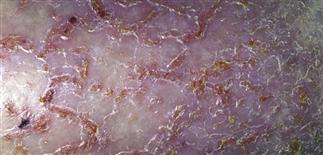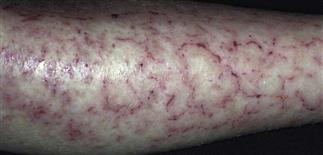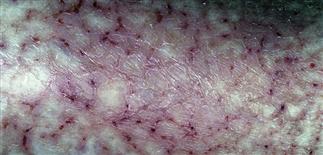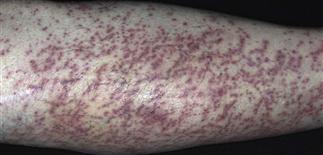Asteatotic eczema

A dry, cracked, almost fissured-looking skin surface characterizes asteatotic eczema. Winter and low humidity often prompt this condition in the elderly. Daily bland emollient use is helpful.

Asteatotic eczema can be severe enough to result in fissuring and heme crusting of the skin. This condition is tender and uncomfortable.

The skin in asteatotic eczema is often described as having a ‘cracked pavement’ appearance.

Asteatotic eczema with prominent follicular inflammation.
DESCRIPTION
Distinctive clinical pattern of eczematous dermatitis caused by excessive dryness and chapping. Also referred to as eczema craquelé.
HISTORY
Asteatotic eczema is a form of subacute eczematous dermatitis that tends to be chronic and low grade, with wintertime seasonal flares due to low humidity. Peaks in late winter and improves in summer, especially in colder, drier climates. • More common in patients with the atopic diathesis, more common in older individuals. • Most patients have a history of previous similar flares. • Any site may be affected, although lower legs most commonly involved. • Early, affected individuals often note that skin looks and feels dry. • With progression, itch and increasing inflammation become most prominent symptoms. • Burning, stinging occur in advanced cases with fissures, crusting.
PHYSICAL FINDINGS
• Clinical picture is a subacute eczematous dermatitis. • Xerosis with accentuated skin markings are features. • Inflammation, first subtle, becomes more pronounced over time. • Faint, poorly defined erythema progresses to fiery red, acute eczematous papules. • Vesicles are not typically seen, although excoriations are nearly universal. • Dry, thin desquamation progresses toward a pattern termed eczema craquelé, with thin superficial fissures. • With progression, the eczema develops acute features with weeping, crusting, intense erythema.
TREATMENT
• Therapy is determined by stage (acute, subacute, chronic) of asteatotic eczema and degree of inflammation. • For xerosis, therapy consists of sensitive skin measures, namely limited use of mild soap and liberal use of emollients. • Petrolatum offers preservative-free choice as a lubricant; compliance may be difficult. • Moisturizers containing lactic acid, urea, or glycolic acid may also be useful. • Early inflammation best treated topically with a medium-potency corticosteroid, preferably in an ointment base. • Therapy should be continued until erythema and scaling resolve, about 2–3 weeks. Liberal use of emollients should then be continued as prophylaxis against recurrence. Bland, fragrance-free emollients (Vanicream, Aveeno) or Cetaphil creams or hydrolatum are best. • Localized flares with acute eczematous features of weeping and crusting should be treated as acute eczema. Patients require close follow-up during this stage, because localized flares may become generalized. • Wet dressings with Burow’s solution along with medium-potency topical corticosteroid cream helpful. • Oral antibiotics may be indicated for secondary impetiginization. • Once weeping, induration, and crusting improve, stop wet dressings. • A medium-potency topical corticosteroid ointment (group II or IV) should be continued until redness and scaling resolve, approximately 2–3 weeks. Thereafter, sensitive skin care, including daily bland emollient use, is helpful in limiting recurrence.







